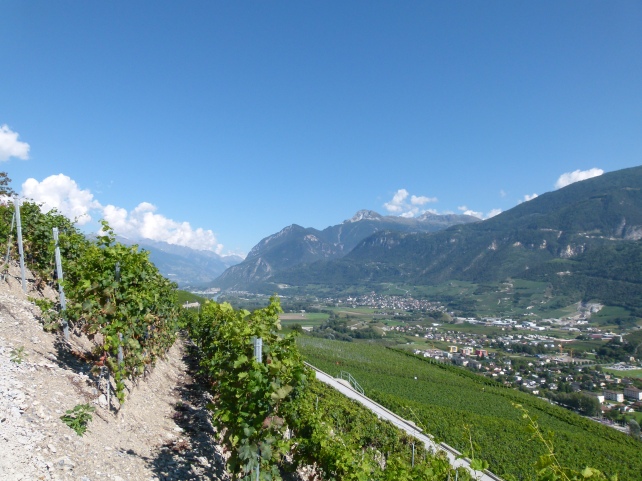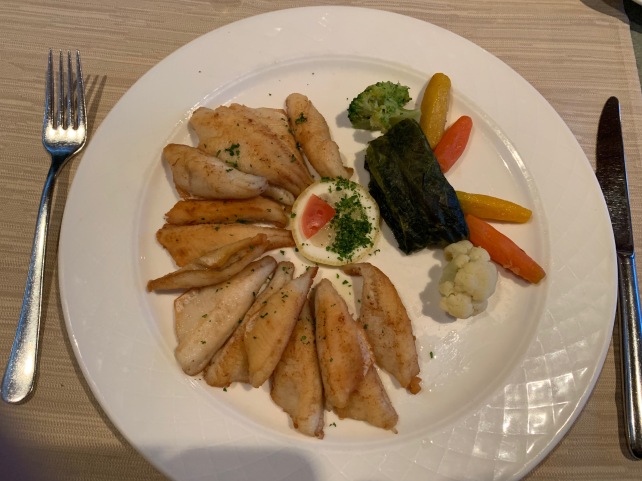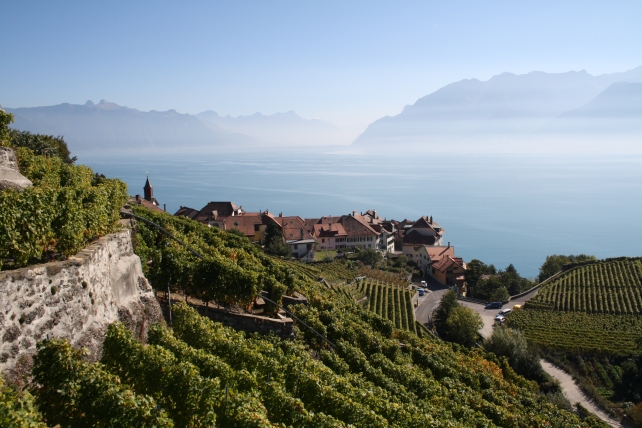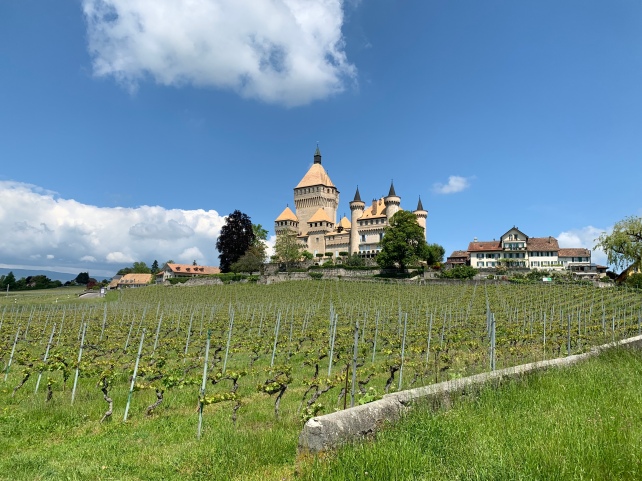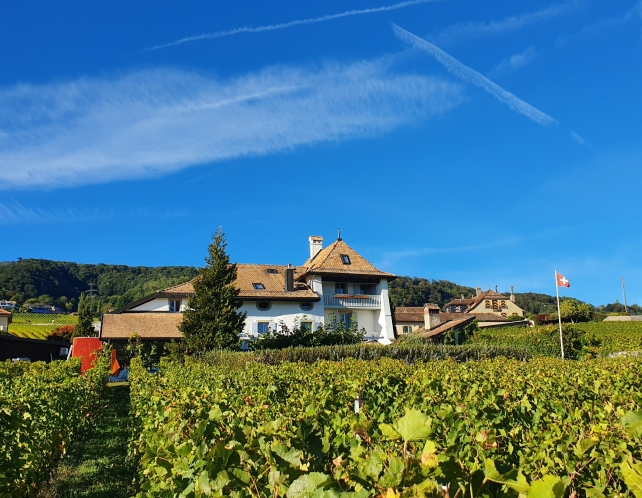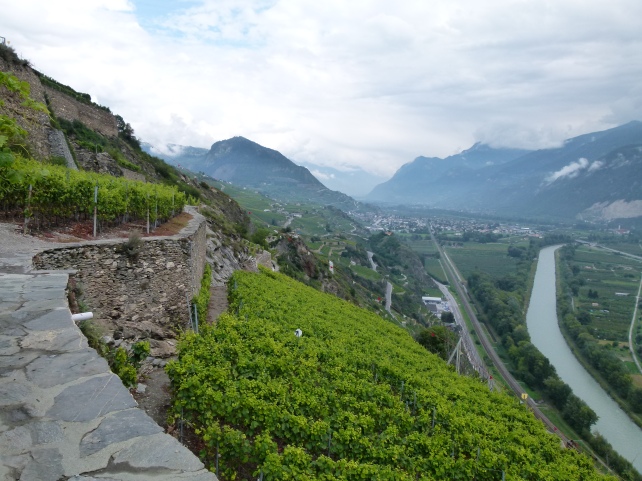Switzerland is famous for many things; banks, mountains, lakes, cheese, chocolate and, erroneously – courtesy of Orson Wells – cuckoo clocks. Not many people, in Britain anyway, seem to associate this Alpine country with wine.
Swiss wine is a bit of a mystery because almost none of it is exported. The Swiss are a thirsty lot and they drink 98% of their own wine and still import two thirds of what they consume. So it is hardly surprising that so little Swiss wine leaves the country. Astonishingly Switzerland has a mere 0.2% of the world’s wine growing area. With just 15,000 hectares of vines in the whole country, it’s half the size of France’s Burgundy region – itself far from being a large producer.
Despite this lack of an international reputation, Swiss wines are really exciting and deserve our attention. It is a beautiful country with some of the most stunning scenery in Europe. Swiss food is hearty and delicious and in its simplicity and honesty shows how agrarian Switzerland has always been. The cheeses, such as Emmental and Gruyère are far finer than the versions that we generally buy in our supermarkets and seem to genuinely reflect their origins. Of course a meal of fondue or raclette takes eating cheese to another, more exciting level. The peasant roots of Swiss cuisine also show in that other famous and satisfying dish, rösti. Not all Swiss food is heavy though, around Lac Léman perch fillets from the lake are a delicious speciality and are perfect with a glass or two of the local wine.
When in Switzerland I am always struck by the high quality of all the produce, including the wine, of which the country produces a plethora of styles. White wine is dominant, as you might imagine from the cool climate, but the reds can be astonishingly good too. Chasselas is the most famous and important white grape within Switzerland – and yet few non Swiss wine drinkers would ever give it a moment’s thought. Of course there is also plenty of Chardonnay, Pinot Gris, Riesling, Sylvaner, Pinot Blanc and Gewürztraminer as well as the indigenous white grapes of Petite Arvine, Humagne Blanc, Heida and Réze. Pinot Noir and Gamay are the most widely encountered black grapes, while Merlot and Syrah are also highly prized. Indigenous black grapes include Humagne Rouge, Cornalin, Gamaret, Diolinoir and Garanoir.
Strangely the principal grape variety of Ticino – the Italian speaking part of Switzerland – is Merlot, where unusually it is used to make both red and white wines.
I have travelled extensively in the French speaking areas in recent years and thought I would share some of these exciting wines with you as they are very versatile with food and would be really exciting to see on restaurant wine lists.
The Regions – Vaud

La Suisse paddle steamer, one of the small fleet of pre First World War steamers that criss-cross Lac Léman – photo by Quentin Sadler.
Vaud is probably Switzerland’s most famous wine region. This is where you find Lausanne and Montreux and one of the most iconic landscapes in Europe. At its heart is the steeply terraced vineyards of Lavaux on the north shore of Lac Léman – Lake Geneva to us Brits.
The key grape here is Chasselas, which is taken very seriously in Switzerland despite being little-loved anywhere else. It seems to be common practice to put the better wines through Malolactic Conversion, which softens the acidity and gives a pleasing creamy quality and mouthfeel that makes them a perfect partner to cheese. Lucky that, as in one form or another they eat a great deal of cheese in Switzerland.
The dominant black grape is Pinot Noir, which is used to great effect in Chablais and around Lake Neuchâtel to make very fruity reds, finer, more structured reds and some excellent rosés, labelled as Oeil-de-Perdrix.
Vaud: Lavaux
Lavaux is a UNESCO World Heritage Site with stunning vineyards cascading down the slopes and terraces to the shore of Lac Léman. There are six appellations, or ‘Crus’: Lutry, Villette, Epesses, Saint-Saphorin, Chardonne and Montreux-Vevey. In addition Dézaley and Calamin are both classified as Grand Cru, which means the grapes must contain higher sugar than normal at harvest. This ensures the wines will be richer and rounder.
The chalky limestone soils should suit Chardonnay perfectly, but around here the speciality is Chasselas. In fact it accounts for 80% of production and if no other grape is mentioned on the label of a Lavaux white, then it’s made from 100% Chasselas.
The vineyards are steep, so everything must be done by hand and it’s backbreaking work. Marcel Dubois, who makes wine near Epesses, famously said: ‘We are condemned to make expensive wine so we might as well make it good wine’. And it seems to me that the Swiss have taken that concept of quality to heart.

Lavaux from the deck of La Suisse paddle steamer, one of the small fleet of pre First World War steamers that criss-cross the lake – photo by Quentin Sadler.
The wines made here benefit from what the locals call the ‘three suns’, there is direct sunshine, reflected sunshine from the surface of the lake and the light and heat reflected off the stone walls that define the vineyards. All of this makes the Chasselas from here richer, more structured and more intense than other areas.
Recommended producers:
Louis-Philippe Bovard is the 10th generation of the family to farm their 18-hectare estate in Cully near Epesses. He grows many different grapes, but Chasselas is his main focus.
His Médinette Dézaley Grand Cru has a very delicate weight, but a solid core of concentrated fruit and a long, stony mineral finish.
Luc is one of the region’s famous producers and farms breathtakingly beautiful vineyards in Epesses, Clos du Boux, Saint-Saphorin, Dézaley-Marsens and Dézaley – all the greatest sites of Lavaux.
The real speciality here is the legendary Dézaley Chemin de Fer. Late in the nineteenth century, the railway line was put through and some of the land in Dézaley had to be sacrificed to make way for progress. Little parcels of land were left at the bottom of the slope around the railway lines and Luc’s grandfather acquired the rights to plant on them. The wine is a magnificent, mineral and complex white wine with that touch of creaminess and generosity that sets Swiss Chasselas apart.
Vaud: La Côte
This Vaud sub-region curves around the north western shore of Lac Léman from the outskirts of Lausanne to the edge of Geneva. The vineyards slope – La Côte means slope – down towards the lake shore on the foothills of the Jura Mountains. It’s a big, productive area that makes some terrifically drinkable wines.
Chasselas from here tends to be lighter, fresher and more quaffable than their counterparts in Lavaux, although the Grand Cru sites of Féchy, Morges and Mont-sur-Rolle produce more concentrated and fine examples. Pinot Noir and Gamay are used to make similarly attractive, fruity red wines.
Recommended producers:
This fabulous 10 hectare estate looks down on the lake from Mont-sur-Rolle, just to the north of Rolle itself. The Maison Blanche dates from the thirteenth century and has belonged to current owners the de Mestral family since 1528.
I have always enjoyed their Chasselas, especially their Mont-sur-Rolle Grand Cru, which is a fine, creamy, floral scented delight. They also make some delicious traditional method sparkling Chasselas.
Vaud: Chablais
The southernmost part of Vaud, with vineyards concentrated between the River Rhône and the Alps, the best being on the slopes to the east. The landscape might not be as dramatic as its neighbours to the north and south, but the area can claim to be home to some very fine wines. Of the five Chablais ‘Crus’, Yvorne and Aigle are perhaps the most well known – especially for the whites made from Chasselas. Aigle is dear to my heart as most years I spend a few days at the beautiful Château d’Aigle judging Chasselas wines in the Mondial du Chasselas competition.
Recommended producers:
This large company owns some amazing vineyards and produces a large range of very well made wine. The pinnacle of what they do is probably the Clos du Rocher Grand Cru Chasselas in Yvonne, a wine I love.
I have been fortunate enough to taste every vintage of Clos du Rocher back to the 1982. All were still fresh and lively, although the older examples had developed a more golden colour, dried fruit and mushroom character. What’s more every vintage since 1990 was sealed with screwcap.
Bernard Cavé Vins, Aigle

The concrete egg shaped fermentation tanks at Bernard Cavé Vins, he calls them amphoras – photo by Quentin Sadler.
All the wines are superb, notably the exquisite Clos du Crosex Grillé Cuvée des Immortels Reserve Aigle Grand Cru. Fermented in concrete eggs, this is textured, round and silky too. In the unlikely event that you tire of his Chasselas, his Marsanne – called Ermitage locally – is stunningly rich and downright delicious.
Badoux Vins, Aigle
Founded in 1908, Badoux produces a wide range of thoroughly reliable wines. Their most emblematic label is their Aigle Les Murailles, named after the stone walls that support the incredibly steep vineyards of Aigle. The excellent white is a pure and mineral Chasselas with a touch of richness, while the red is a bright, fruity Pinot Noir that has been aged on the lees from Gamaret, a local speciality grape that is a cross of Gamay and Reichensteiner.
The Regions – Neuchâtel
This small region sits on a south-east facing slope between the Jura Mountains and the shores of Lakes Neuchâtel and Bienne. It acts like a sun trap and has very poor soils, so can produce beautifully ripe wines.
Recommended producers:
This winery has been in the pretty lakeside village of Auvernier since 1603 and makes a range of really good wines. My favourites would be their elegant and concentrated Neuchâtel Blanc, made from Chasselas, the Pinot Noir and their Oeil-de-Perdrix Pinot Rosé.
The Regions – Valais
The Canton of Valais is south and east of Lac Léman. The River Rhône flows through here before emptying into Lac Léman and the best vineyards, Grand Crus like Fully, Vétroz, Sion and Sierre, line the bank of the river on incredibly steep slopes that are kept workable by dry stone walls. To get to those owned by Robert Gilliard at Sion, for instance, I was driven up into the mountains to the entrance of a short, narrow tunnel. At the other end of this I found myself on one of the terraces, or ‘tablars’, formed by the stone walls that I had looked up to on the way. Some of them are 20 metres high and I was told they are the highest dry stone walls in the world.
The views to the south were breathtaking and I could not get enough of them. In the past the grapes had to be taken to the winery through the tunnel, then in the twentieth century a cable car system was adopted. Nowadays a lot of the work is done by helicopter, which gets the grapes to the winery while they are still in perfect condition. These dramatic south facing slopes are warm and dry in the growing season, but always tempered by the fresh, Alpine air – Switzerland’s highest peaks are in the Valais with some of the vineyards near Visp being well over 1000 metres above sea level.
Chasselas is still an important grape in these parts, but locally they call it Fendant – pronounced Fon-dohn – from the French ‘fendre’ meaning to split – as the grape skin easily splits when ripe.
Another important white grape here, perhaps the real speciality, is Petite Arvine. It isn’t grown in many other places, even in Switzerland, except Italy’s tiny Valle d’Aosta region which borders Valais to the south. At its best Petite Arvine has something of the freshness and vivaciousness of Grüner Veltliner and Albariño about it, but often with more salinity, so giving tension, and fruit (especially grapefruit), moderate acidity and a silky quality to the texture.
Valais is also home to the most famous Swiss wine of all – Dôle. This is always a blend of Pinot Noir and Gamay and can also include some other black grapes to add complexity. Usually red, Dôle Blanche is an intriguing and very high quality rosé made from the same blend.
Recommended producers:
Provins, Sion
Provins are Switzerland’s largest producer and everything I have tasted from them has been superbly made. My favourite though is their subtly oaked Petite Arvine Maître de Chais – it’s classy, with lots of citrus fruit, a fleshy, creamy texture and a feeling of purity about it, like a mountain stream.
Cave Philippe & Véronyc Mettaz, Fully
This small estate farms just 8 hectares but makes a wide range from the many grape varieties of Valais. Theirs was the first Petite Arvine that I ever tasted and I was hooked.
Robert Gilliard, Sion
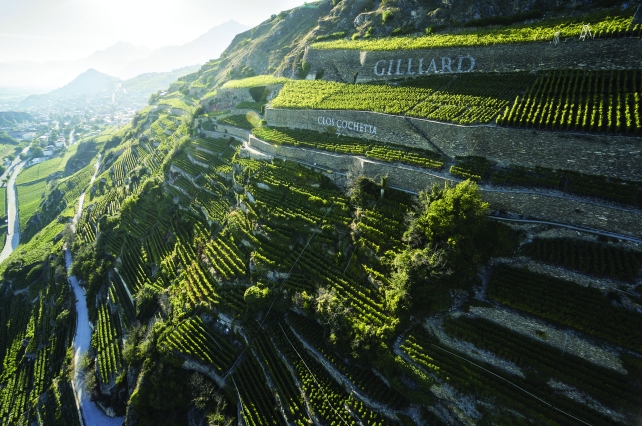
Robert Gilliard’s dramatic Clos de la Cochetta vineyard contains some of the highest dry stone walls in the world – photo courtesy of Robert Gilliard.
This estate boasts some of the most beautiful and dramatic vineyards that I have ever seen. They truly take your breathe away clinging as they do to almost perpendicular slopes kept in place by terrifyingly high stone walls of up to 20 metres.
Their Clos de Cochetta Fendant is vibrant, lightly textured, elegant and classy, as is their focussed and pure Clos de Cochetta Petite Arvine.
Just along the terraces is the neighbouring vineyard of Clos de Mont from which they craft a fine, unoaked example of Diolinoir which is a cross between Robin Noir (aka Rouge de Diolly) and Pinot Noir.
Domaine Jean-René Germanier, Vétroz
A family estate since 1896 and now managed by the third and fourth generation – Jean-René Germanier and his nephew, Gilles Besse. Gilles was originally a jazz saxophonist, but is also a trained wine maker.
Germanier farm sustainably and produce a range of beautifully made, elegant wines, amongst which is their Cayas Syrah. This spicy, yet precise and mineral wine is possibly the best Syrah in the country and made within sight of the Rhône river.
Their Grand Cru Petite Arvine and Fendant Balavaud Grand Cru are equally exciting and impressive, while their Dôle Balavaud is one of the classics of its type.
Every time I have visited Switzerland I have come away with a very positive view of the wine. The dedication, heroism even, needed to tend and harvest the vines in this mountainous landscape is incredible to see. The passion the winemakers show in crafting these raw materials into beautifully made wines that are full of character and interest is always an education. I believe these wines deserve wider recognition and think it would be very exciting to see Swiss wines on restaurant wine lists.
Many of the wines mentioned here are available in the UK from Alpine Wines – www.alpinewines.co.uk.
Owned and run by Swiss born Joelle Nebbe-Mornod, Alpine Wines are the leading Swiss wine importers and distributors in the UK.

